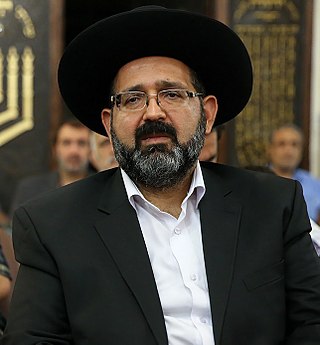
Iranian Jews constitute one of the oldest communities of the Jewish diaspora. Dating back to the biblical era, they originate from the Jews who relocated to Iran during the time of the Achaemenid Empire. Books of the Hebrew Bible bring together an extensive narrative shedding light on contemporary Jewish life experiences in ancient Iran; there has been a continuous Jewish presence in Iran since at least the time of Cyrus the Great, who led Achaemenid army's conquest of the Neo-Babylonian Empire and subsequently freed the Judahites from the Babylonian captivity.

The history of the Jews in Morocco goes back to ancient times. Moroccan Jews constitute an ancient community. Before the founding of the State of Israel in 1948, there were about 265,000 Jews in the country, with a maximum of between 250,000 and 350,000 at its peak in the 1950s, which gave Morocco the largest Jewish community in the Muslim world, but by 2017 only 2,000 or so remained. Jews in Morocco, originally speakers of Berber languages, Judeo-Moroccan Arabic or Judaeo-Spanish, were the first in the country to adopt the French language in the mid-19th century, and unlike among the Muslim population French remains the main language of members of the Jewish community there.
Shiraz pogrom or Shiraz blood libelof 1910 was a pogrom of the Jewish quarter in Shiraz, Iran, on October 30, 1910, organized by the Qavam family and sparked by accusations that the Jews had ritually killed a Muslim girl. In the course of the pogrom, 12 Jews were killed and about 50 were injured, and 6,000 Jews of Shiraz were robbed of all their possessions. The event was documented by the representative of the Alliance Israélite Universelle in Shiraz.

The Yusef Abad Synagogue, officially Sukkot Shalom Synagogue, is an Orthodox Jewish congregation and synagogue, located at the junction of 15th Street and Sayyed Jamáleddin e Asadábádi Ave, in the Yusef Abad neighborhood of Tehran, in Iran.

Haroun Yashayaei is former chairman of the board of the Tehran Jewish Committee and former leader of Iran's Jewish community. On January 26, 2006, Yashayaei's letter to the Iranian President Mahmoud Ahmadinejad, concerning his Holocaust denial comments, brought about worldwide media attention, including an interview with Der Spiegel.
The Tehran Jewish Committee, formally registered in 1934, is an umbrella group of Jewish organizations that work on behalf of the Iranian Jews in Iran.

The Abrishami Synagogue is an Orthodox Jewish congregation and synagogue, located in the Kakh Shomali neighborhood of Tehran, Iran. The synagogue is situated within a compound that also includes a Jewish school, a beit midrash, a mikveh, and a kosher restaurant.
Exodus of Iranian Jews refers to the emigration of Persian Jews from Iran in the 1950s and the later migration wave from the country during and after the Iranian Revolution of 1979, during which the community of 80,000 dropped to less than 20,000. The migration of Persian Jews after the Iranian Revolution is mostly attributed to fear of religious persecution, economic hardships and insecurity after the deposition of the Imperial government.

Oudlajan is a historic neighborhood in Tehran, Iran. The neighborhood is surrounded by Pamenar Street, Cyrus Street, Cheragh Bargh and BozarJomehr Street. Oudlajan, in addition to Arg, Dolat, Sangelaj, Bazar and Chalmeidan, constituted Old Tehran during the reign of Naser al-Din Shah Qajar. Old Oudlajan consisted of 2619 houses and 1146 shops and was one of the biggest and wealthiest neighborhoods in Tehran.
The Ettefagh Synagogue is a Jewish congregation and synagogue, located on Ghods Street, in Tehran, in the Central District of Tehran County, in Iran.
The Khorasaniha Synagogue is a Jewish congregation and synagogue, located at the junction of Zartosht and Valiasr Streets in Tehran, Iran.
The Molla Hanina Synagogue or Mollah Haninah Synagogue, is a Jewish congregation and synagogue, located at 7 Sarjonbak Alley, in the Old Jewish Quarter, in the Oudlajan neighborhood of Tehran, Iran. Established in the late 19th century, it is one of the oldest and, located on a 127 m2 (1,370 sq ft) site, one of the smallest synagogues in Tehran.
The Ezra Yaghoub Synagogue is an Orthodox Jewish congregation and synagogue, located in the Old Jewish Quarter, in the Oudlajan neighborhood of Tehran, Iran. Completed in 1895, the synagogue is one of oldest synagogues in Tehran.
Rah-e Danesh Synagogue is a Jewish congregation and synagogue, located near Yusefabad Street in Tehran, Iran.
Jack Mahfar is an Iranian businessman, who was born in 1931 in Esfahan, Iran. He started his pharmaceutical business in Tehran and was working for the foundation of a pharmaceutical products factory for the state. He had to terminate the project due to the Iranian Revolution.

Rabbi Younes Hamami Lalehzar is the current religious leader of Iranian Jews.
Alliance school Tehran was the first Alliance Israélite Universelle school built in Iran. Located in the capital Tehran and founded in 1898, it was the first western style school in Iran, and is still open today.
Alliance School Kermanshah was a Jewish school in the western Iranian city of Kermanshah, founded by the Alliance Israélite Universelle. It provided education up to 18 years old and had two annexes; one for girls and one for boys.







